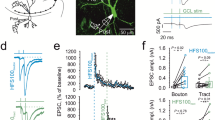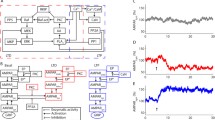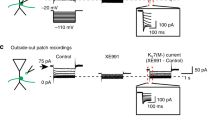Abstract
We simulated synaptic transmission and modified a simple model of long-term potentiation and long-term depression in order to describe the long-term plasticity-related changes in cerebellar mossy fiber–granule cell synapses. In our model, protein autophosphorylation, leading to the maintenance of long-term plasticity, is controlled by Ca2+ entry through the NMDA receptor channels. The observed nonlinearity in the development of long-term changes of EPSP in granule cells is explained by the difference in the rate constants of two independent autocatalytic processes.
Similar content being viewed by others
REFERENCES
Ch. Hansel, D. J. Linden, and E. D'Angelo, “Beyond parallel fiber LTD: the diversity of synaptic and non-synaptic plasticity in the cerebellum,” Nat. Neurosci., 4,No. 5, 467–475 (2001).
S. Armano, P. Rossi, V. Taglietti, and E. D'Angelo, “Long-tern potentiation of intrinsic excitability at the mossy fiber-granule cell synapse of rat,” J. Neurosci., 20, 5208–5216 (2000).
M. Migliore and P. Lansky, “Long-term potentiation and depression induced by a stochastic conditioning of a model synapse,” Biophys. J., 77, 1234–1243 (1999).
E. D'Angelo, Th. Nieus, A. Maffei, et al., “Theta-frequency bursting and resonance in cerebellar granule cells: experimental evidence and modeling of a slow K+-dependent mechanism,” J. Neurosci., 21, 759–770 (2001).
P. Jonas, G. Major, and B. Sakmann, “Quantal components of unitary EPSCs at the mossy fibre synapse on CA3 pyramidal cells of rat hippocampus,” J. Physiol., 472, 615–663 (1993).
R. A. Lester and L. E. Jahr, “NMDA channel behavior depends on agonist affinity,” J. Neurosci., 12, 635–643 (1992).
Z. F. Mainen, R. Malinow, and K. Svoboda, “Synaptic calcium transients in single spines indicate that NMDA receptors are not saturated,” Nature, 399,No. 6732, 151–154 (1999).
Author information
Authors and Affiliations
Corresponding author
Rights and permissions
About this article
Cite this article
Saftenku, E.É. A Simplified Model of Long-Term Plasticity in Cerebellar Mossy Fiber–Granule Cell Synapses. Neurophysiology 34, 216–218 (2002). https://doi.org/10.1023/A:1020723921430
Issue Date:
DOI: https://doi.org/10.1023/A:1020723921430




